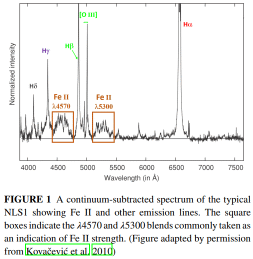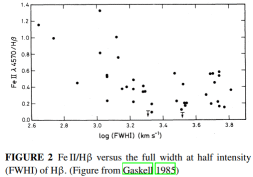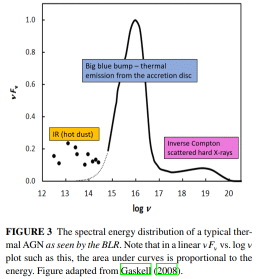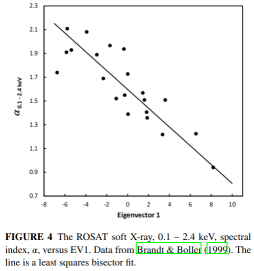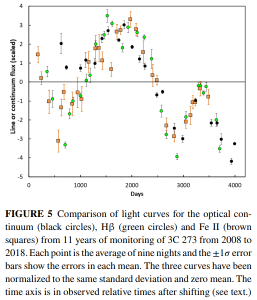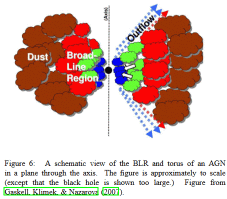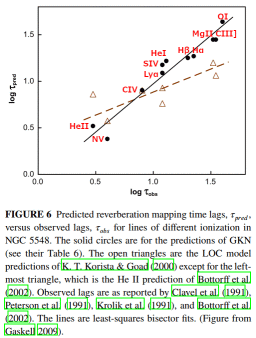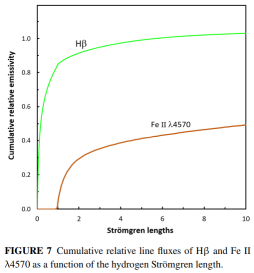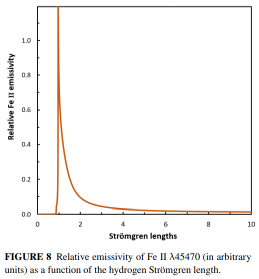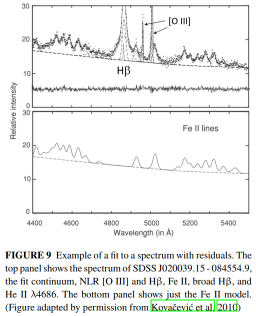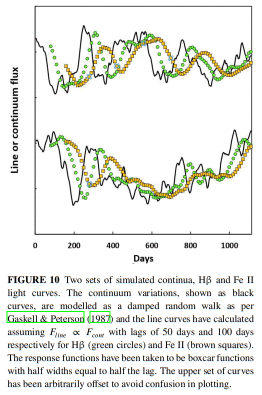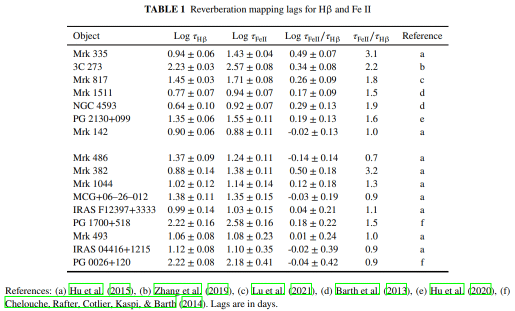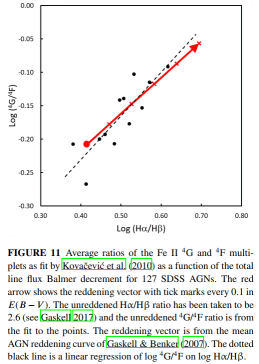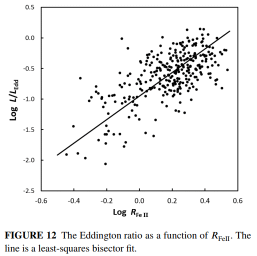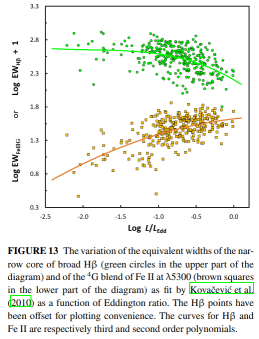FeII emission in active galactic nuclei
Introduction
- AGN での FeII 輝線
Wampler & Oke (1967): 3C 273 で発見
Fe+ が多数の準位を持つため輝線が非常に密
通常は Doppler 幅が広いので繋がってしまう - NLS1
Sargent (1968): I Zw 1 では FeII 輝線の幅が狭く分離できることを発見
Doppler 幅は異なるが輝線比は 3C 273 と大体同じ
I Zw 1 は NLS1 と分類される (Gaskell, 1984; Osterbrock & Pogge, 1985)
Background
FeII in Galactic objects
- 歴史
Moore & Sanford(1914): η Carinae で FeII 検出
Stratton & Manning (1939): Nova Herculis 1934 で FeII 検出
→ Wampler & Oke (1967) で 3C 273 での同定に利用
Thackeray (1953): RR Telescopii で非常に細く強い FeII 検出 - 初期の疑問点
なぜ planetary nebulae や HII region では FeII が非常に弱いのか?
De Boer et al. (1972): Fe は dust に取り込まれている
FeII が強い天体では gas 密度が高く dust に取り込まれていない
FeII in 3C 273
- AGN での輝線
Dibai & Pronik (1967): NLR, BLR 2つの放射領域を定義
NLR: ne~103/cm3, ~100pc
BLR: ne>106/cm3, <1pc
Galactic object の FeII は NLR から出る禁制線相当で、BLR の FeII とは異なる
Wampler & Oke (1967): 3C 273 からは [FeII] は検出できなかった
→ FeII は ne>107/cm3 領域から出ている
FeII, MgII は同じような領域から出ており、Mg/Fe は solar abundance 程度
Seven remarkable things about optical FeII emission
Relative strength
Strong object-to-object differences
- FeII は他の AGN 広輝線には見られないほど強度や幅がまちまち
理論モデルとしては、非常に強いものも説明できる必要がある
Correlation with line widths
- FeII の強度と Hβ 幅は反相関の性質が見られる↑
Correlation with radio type
- 通常の radio-loud 天体では FeII は弱い
Seyfert 1 で FeII の強い天体が多い (Osterbrock 1977, Grandi & Osterbrock 1978)
flat-spectrum source で FeII が強い (Setti & Woltjer 1977, Miley & Miller 1979)
Correlation with galaxy type
- 電波銀河は巨大楕円銀河で FeII は弱い
Seyfert 1 は通常は渦巻銀河で FeII が強いものが多い
母銀河の type や質量に関係ある可能性もある
Correlation with the narrow-line region
- FeII が弱い AGN は [OIII] が強い (Grandi & Osterbrock 1978)
FeII が強い Type A, FeII が弱い Type B (Steiner 1981)
Type A では [O III]/Hβ が連続光強度と反相関、Type B では [OIII] が強く相関なし - 主成分解析 (Boroson & Green 1992)
eigenvector 1 (EV1): FeII/Hβ - FWHM(Hβ) 反相関、FeIIλ4570/Hβ - [OIII]/Hβ 反相関
(前者の図は後に quasar の main sequence と呼ばれるようになる)
Correlation with soft X-ray excess
How and where is FeII emission produced?
- broad Balmer lines
UV 連続光の変動と強度相関がある → photoionization
CIV, Lyα, HeIIλ1640 も同様 - FeII のエネルギー源として提案されているもの
low-temperature dense gas (Collin-Souffrin, Dumont, & Tully 1982, Joly 1987)
hard X による accretion disk 外周部照射 (Collin-Souffrin, Hameury, & Joly 1988)
small-scale jet (Zheng & Keel 1991)
jet による shock (Joly 1991)
photoionization model では説明できない (Collin & Joly 2000)
Fe の overabundance + shock 説が有力
UV FeII も shock の可能性がある (Baldwin et al. 2004) - 難しい点
Akn 120 の分光モニタで reverberation mapping が検出できない
photoionization 以外が原因 or Hβ よりも数倍広い範囲で光っている (Kuehn et al. 2008)
Is FeII emission caused by photoionization?
- 最近の reverberation mapping の結果
(9晩の観測を平均してエラー付き1点にしている)FeII の変光振幅は Hβ の 73%
delay は Hβ 270d、FeII 450d (同程度に見えなくもないが...)
これ見ると FeII は photoionization に見えるが、問題もある(以下)
The structure of the BLR: the Gaskell, Klimek & Nazarova model
- BLR のイメージ (Gaskell et al. 2009)
low-ionization component ほどこの中で円盤状に分布している
pole 方向には穴が開いている(Lyα に吸収端がないことから)
accretin disk とともに回転
Reverberation mapping に適用した結果
BL 輝線形状の説明には多くのパラメータの輝線の重ね合わせが必要
単一の optically thick cloud で説明しようとすると RM の結果と合わない↓
Photoionization modelling of FeII emission
-
2007年の時点では FeII の delay が検出できていなかったが、
現在はデータがあるので FeII 輝線領域をモデル化できる
Model parameters
- Cloudy 17.10 (Ferland et al. 2017) を使用
入射 UV continuum は過去の結果との比較のため Mathews & Ferland (1987) を使用
密度 nH=1011/cm3, solar abundance
計算は column density 1025/cm まで
ionization parameter -2.5 < logU < +0.5 で計算
FeII は λ4570, λ5300 両方のグループそれぞれで評価
Strength of optical FeII emission
- Fe+ の ization potential は 16.18eV
→ Strömgren 半径付近から光るが、その外側では中性 H の増加で UV が取られるStrömgren 半径の数倍のところに dust torus があるので BLR はそこまで
- RFeII = F4570/FHβ
このモデルでは RFeII ≈ 0.35 で Fig.2 と合う
[Fe/H] が2~3 solar であれば RFeII 大のものも説明可
Responsivities of FeII and Hβ
- 以前は FeII は hard X からエネルギーを受け取っていて
他の輝線とは振る舞いが異なると考えられていた
→ αox が flat であるほど FeII が強くなるはずだが実際は逆
→ これは違う
Predicted effective radii for FeII
- RM 結果を説明できるか?
モデル:emissivity-weighted radius の比 = 2.1 (Fig.7)
RM :responsivity-weighted radius (Fig.8 を重みとする平均値のようなもの)だが、
UV continuum が強くなると Fe+ ⇒ Fe++ となってしまうので外側にずれる
→ responsivity-weighted radius の比 ~ 1.5 - 2.2 で RM 結果とも合う
→ OI とほぼ同じ距離で MgII よりも 10% 大きい (Fig.6)
Line widths
- 輝線幅からの放射領域の推定
I Zw 1 では FeII の輝線幅は Hβ の 75-100% (Phillips 1978)
↓FeII 輝線幅測定例RM の delay と輝線幅には相関がある(Krolik et al. 1991)
SDSS AGN では FeII の幅は Hβ の 71% (Hu et al. 2008)
→ FeII の放射領域は Hβ の約2倍
近赤外の FeII/Paβ でも同様な結果 (Marinello et al. 2016)
Reverberation mapping
Problem number one: FeII variability is reduced and smeared out because of the larger region size
- シミュレーション
damped random walk (DRW) モデル
連続光:τdump=10日
Hβ :delay 50日
FeII :delay 100日smoothing の効果で FeII の方が変光しづらくなる
最近の RM 結果では FeII変更幅/Hβ変更幅 = 83% (Lu et al. 2021 ほか)
FeII 輝線強度は計測しづらいことも難しい要因
Problem number two: Narrow-line Seyfert 1s are less variable than broad-line AGNs
- NLS1
FeII は非常に強いが、ほとんど変光しない
Ark 564 は17年間観測されたが、RM は全て失敗 (Doroshenko et al. 2006 ほか)
変光が細かすぎて、外側ではほとんど変化しないという事情もある
Reverberation-mapping results
- 異なる結果
τFeII/τHβ≈1 (Chelouche et al. 2014, Hu et al. 2015)
信頼度の高い順に FeII RM 結果を並べてみると、エラーが大きいものは比が小さい傾向があるS/N が悪く観測期間が短い場合は delay は過少評価される
→ エラーの小さいものを信用すればこれまでの話の通りで問題なし
"Anomalies" in reverberation mapping responses
- 特異な状況
Fig.5 の始めの1000日は明るさが合わない
2000日付近の連続光の減り方もその後の輝線の変化とは異なる
→ 強度が合わない・delay の変化 はどの sample にも見られる
FeII の輝線領域の広がりを調べるのは大変... - Gaskell et al. (2021)
NGC5548 の長期 RM 観測では、特異な状況は非等方放射か
コンパクトなUV吸収体が関係している
The FeII emitting region in context
Relationship to other low-ionization lines
- 低励起輝線
OI, CaII, FeII は輝線幅が大体同じ (Marinello et al. 2016)
O, Mg+, Ca+, Fe+ のイオン化エネルギーは 13.6, 15.0, 11.9, 16.2 eV で大体同じで
Mg, Ca, Fe だと 7.6, 6,1, 7.9 eV となり、HII region 透過 UV でもイオン化できる
これらの輝線は放射領域が広くて変動しづらく RM が難しい
Relationship to the surrounding dust
- hot dust の位置
hot dust の RM 結果では Hβ の 3.5倍の距離 (Suganuma et al. 2006)
低励起輝線はこれにかなり近いので見えづらい可能性がある
The microphysics of FeII emission
Physical processes
- FeII の励起メカニズム
Collisional excitation + self-fluorescence (Netzer & Wills 1983, Wills, Netzer, & Wills 1985)
Lyα fluorescence (Johansson & Jordan 1984, Penston 1987)
optical FeII への寄与は 10-20% (Garcia-Rissmann et al. 2012)
最近のモデルでは 10万準位近くを考慮(Sarkar et al. 2021 ほか)
Turbulence and reddening
- Lyα fluorescence に必要な条件
準位の密度が高い+速度幅が大きい
Turbulent velocity ~ 100km/s 程度で small blue bump 最大 (Sarkar et al. 2021) - reddening の効果
UV/optical FeII 比は E(B-V)~0.2 程度の reddening があると説明しやすい (Wills et al. 1985)
FeII Templates
- empirical template
I Zw 1 template + broadening で大体の AGN で合う (Boroson & Green 1992 ほか) - theoretical modelling
まだ完全なモデルは無く、観測と組み合わせた semi-empirical template まで
(I Zw 1 と異なる部分は修正する)
Reddening
- internal reddening は無視できない
↓4G/4F (Kovacevic et al. 2010) と reddening の関係
SDSS で FeII のある赤い quasar 127天体を10天体ずつに分けて平均AGN の内部の状態が異なるという可能性もあるが、reddening の可能性が高い
仮定した reddening タイプはこれ
Eddington ratio: the driver of eigenvector 1
- EV1 (Boroson & Green 1992)
Eddington ratio の違いによる系列と考えられている
L/LEdd大だと BL 幅小 (Wandel & Boller 1998 直接的な図は無い...)
L/LEdd ∝ L/MBH ∝ L/(Rv2) ∝ L1/2v-2
logL/LEdd = 0.5logL5100 - 2logFWHM - 16.3 として評価 (論文では 0.5 が 2.5 となっている...)左下部分が疎となっているのは、Kovacevic et al. (2010) の sample が S/N の良いものに限定しているため
かなり良い相関が見られる (縦軸を EW([OIII]) にしても同様)
scatter の主要因は変光しているため (Eddington ratio もそれにより変化)
L-R 関係の scatter により MBH に不定性があること、
reddening 補正をしていないこと、
metallicity の違い、等も要因
The cause of weak FeII
- dust に取り込まれる metal
Si, Al, Mg, Fe は dust があると aubndance が減少
BLRG で FeII が弱いのは dust が原因 (Osterbrock 1984)
Metallicity
- [Fe/H] の値
巨大銀河の中心では +0.5 程度まで、ガスだと更に +0.2 程度までは考えられるが、
solar abundance でも RFeII の値は説明できるので問題ない
Fe は main coolant となっているのでサチっており abundance の変化には鈍感
高い Eddington ratio の場合でもサチってきていることがわかる↓
The weakening of Hβ
- Hβ に関して
幅の変化は EV1 の一部
Narrow 成分(FeII と同程度の幅)の EW は Eddington ratio と反相関↑
Broad 成分は相関なし
FeII は collision (?)、narrow Hβは photoionization なので振る舞いが異なる
→ heating を効率よく行う soft X の量で状況変化
2-3Zo では >100eV で heavy element の opacity が hydrogen を上回る (Osterbrock & Ferland 2006)
(Eddington ratio 大ほど UV は hard になるということ?
Fe++ になるという話はどうなったの?)
AGN downsizing: the cause of the correlations with radio properties and galaxy type
- Jet を伴う天体の特徴
P5GHz と MBH は正相関 (Franceschini, Vercellone, & Fabian 1998)
Eddington ratio 小 (Blandford-Znajek process で BH spin energy が抜かれるため)
→ FeII は弱くなる
flat-spectrum source の場合は相対論的増光が効いているので MBH のバイアスを受けにくくなる
→ 通常の radio quiet 天体と同様な FeII 分布
Some Future directions
Reverberation mapping
- とにかく、連続した長い分光モニタが必要
高緯度天体をモニタするのがいいだろう
Modelling FeII emission from realistic BLRs
- velocity-resolved RM への適用に耐えうる高精度モデルが必要
Causes of scatter in EV1
- dust への降着の影響があるのでかなり難しい
photoionization condition の違いで注意深く分ける必要がある
Dust and FeII
- AGN 環境による dust 破壊に関して更に詳しく調査する必要がある
Downsizing
- 遠方の AGN の方が活動的で質量降着率が大きい
→ 遠方の方が明るい天体に bias がかかるので注意が必要
→ RFeII の進化を調べるのがいいだろう
An "iron chronometer"?
- FeII/MgII を銀河年齢の判定に使えるか?
FeII/MgII から Fe の abundance を推定することは困難
z < 2 でこの比が小さくなるのは Eddington ratio の減少が原因だろう
